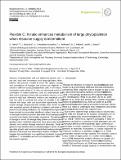| dc.contributor.author | Blackford, J. | |
| dc.contributor.author | Hardman-Mountford, N. J. | |
| dc.contributor.author | Polimene, L. | |
| dc.contributor.author | Geider, R. J. | |
| dc.contributor.author | Talmy, David | |
| dc.contributor.author | Follows, Michael J | |
| dc.date.accessioned | 2014-10-15T12:40:03Z | |
| dc.date.available | 2014-10-15T12:40:03Z | |
| dc.date.issued | 2014-09 | |
| dc.date.submitted | 2014-07 | |
| dc.identifier.issn | 1726-4189 | |
| dc.identifier.uri | http://hdl.handle.net/1721.1/90934 | |
| dc.description.abstract | Phytoplankton cell size influences particle sinking rate, food web interactions and biogeographical distributions. We present a model in which the uptake, storage and assimilation of nitrogen and carbon are explicitly resolved in different-sized phytoplankton cells. In the model, metabolism and cellular C : N ratio are influenced by the accumulation of carbon polymers such as carbohydrate and lipid, which is greatest when cells are nutrient starved, or exposed to high light. Allometric relations and empirical data sets are used to constrain the range of possible C : N, and indicate that larger cells can accumulate significantly more carbon storage compounds than smaller cells. When forced with extended periods of darkness combined with brief exposure to saturating irradiance, the model predicts organisms large enough to accumulate significant carbon reserves may on average synthesize protein and other functional apparatus up to five times faster than smaller organisms. The advantage of storage in terms of average daily protein synthesis rate is greatest when modeled organisms were previously nutrient starved, and carbon storage reservoirs saturated. Small organisms may therefore be at a disadvantage in terms of average daily growth rate in environments that involve prolonged periods of darkness and intermittent nutrient limitation. We suggest this mechanism is a significant constraint on phytoplankton C : N variability and cell size distribution in different oceanic regimes. | en_US |
| dc.description.sponsorship | Gordon and Betty Moore Foundation (Grant GBMF3778) | en_US |
| dc.language.iso | en_US | |
| dc.publisher | Copernicus GmbH | en_US |
| dc.relation.isversionof | http://dx.doi.org/10.5194/bg-11-4881-2014 | en_US |
| dc.rights | Creative Commons Attribution | en_US |
| dc.rights.uri | http://creativecommons.org/licenses/by/3.0/ | en_US |
| dc.source | Copernicus Publications | en_US |
| dc.title | Flexible C : N ratio enhances metabolism of large phytoplankton when resource supply is intermittent | en_US |
| dc.type | Article | en_US |
| dc.identifier.citation | Talmy, D., J. Blackford, N. J. Hardman-Mountford, L. Polimene, M. J. Follows, and R. J. Geider. “Flexible C : N Ratio Enhances Metabolism of Large Phytoplankton When Resource Supply Is Intermittent.” Biogeosciences 11, no. 17 (2014): 4881–4895. | en_US |
| dc.contributor.department | Massachusetts Institute of Technology. Department of Earth, Atmospheric, and Planetary Sciences | en_US |
| dc.contributor.mitauthor | Talmy, David | en_US |
| dc.contributor.mitauthor | Follows, Michael J. | en_US |
| dc.relation.journal | Biogeosciences | en_US |
| dc.eprint.version | Final published version | en_US |
| dc.type.uri | http://purl.org/eprint/type/JournalArticle | en_US |
| eprint.status | http://purl.org/eprint/status/PeerReviewed | en_US |
| dspace.orderedauthors | Talmy, D.; Blackford, J.; Hardman-Mountford, N. J.; Polimene, L.; Follows, M. J.; Geider, R. J. | en_US |
| dc.identifier.orcid | https://orcid.org/0000-0002-7335-2088 | |
| dc.identifier.orcid | https://orcid.org/0000-0002-3102-0341 | |
| mit.license | PUBLISHER_CC | en_US |
| mit.metadata.status | Complete | |
